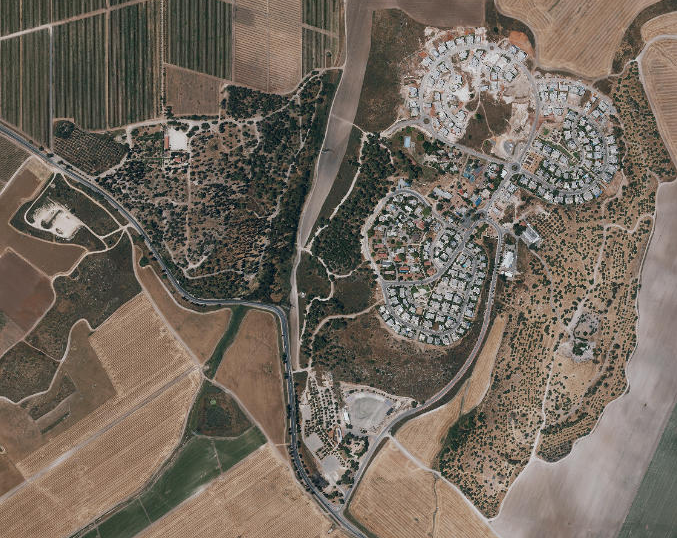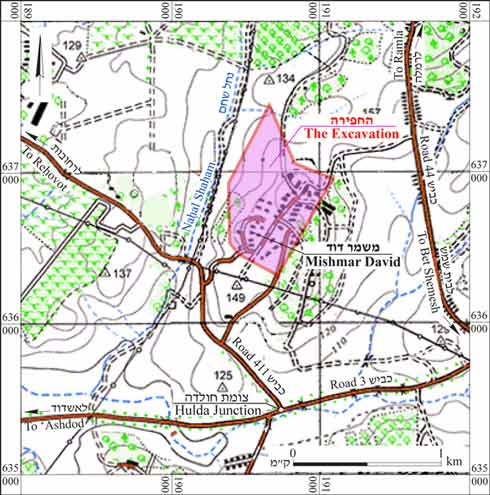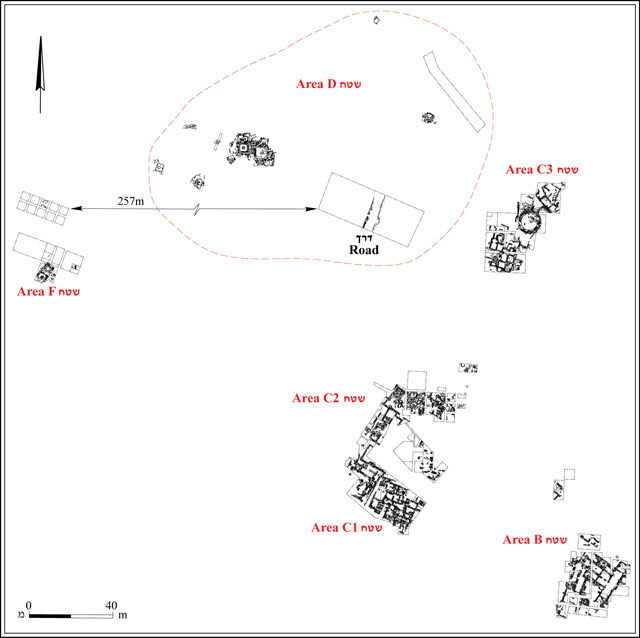 Mishmar David and environs on govmap.gov.il
Mishmar David and environs on govmap.gov.ilclick on image to explore this site on a new tab in govmap.gov.il
 Mishmar David and environs on govmap.gov.il
Mishmar David and environs on govmap.gov.il| Transliterated Name | Language | Name |
|---|---|---|
| Mishmar David | Hebrew | מִשְׁמַר דָּוִד |
| Hulda | Arabic | |
| Khulda | Arabic | |
| The Fortress at Khulda | Greek | τό καστέλι τὸ καλαούμενον Χοῦλδα |
36 This is also the position held by L. Di Segni (personal communication, 2012)

 Fig. 1
Fig. 1
 Fig. 1
Fig. 1

 Fig. 4
Fig. 4
 Fig. 5
Fig. 5
 Fig. 8
Fig. 8

 Fig. 2
Fig. 2

 Fig. 2
Fig. 2
| Stratum | Period | Description |
|---|---|---|
| VII | Late Roman or Early Byzantine | |
| VI | Byzantine-Early Islamic | |
| V | Abbasid to beginning of Fatimid | |
| IV | Fatimid | |
| III | Mamluk | |
| II | Late Ottoman to Beginning of the British Mandate | |
| I | Small children's cemetary |
Taxel (2013:179, 181) describes the site and its potential destruction due to an earthquake as follows:
The results of the excavations (and especially the ceramic and numismatic evidence) indicate that the first intensive occupation of the site occurred no earlier than the late sixth or seventh century, and that this phase continued until the settlement’s destruction sometime in the eighth century, perhaps due to the severe earthquake(s) of 747–749 C.E.Yannai (2014) noted that in Area B
... The destruction of the settlement—apparently in the mid-eighth century—did not interrupt its continuous occupation, though during the following phase, which lasted until the 11th century.
... The two miqvaʾot, as well as a large wine press excavated at the western fringes of the site, went out of use during the eighth century and were converted into refuse dumps. Whether this change was directly connected to the earthquake that possibly hit the settlement,35 or indicates a shift in the religious affinity of its population, is unknown.
Footnotes35 The pottery associated with the reuse of the wine press and one of the miqvaʾot as refuse dumps following their abandonment provided only a general eighth-century date. However, the ceramic assemblage from the other miqveh allows for more precise dating, within the second half of the eighth century
Stratum VI was destroyed in an earthquake (possibly in 749 CE), after which a number of new walls were built in the area (Stratum V).Yannai (2014) noted that in sub-Area C1
the buildings and tower of Stratum VI were destroyed by an earthquake, perhaps in 749 CEafter which
a new quarter of private houses (Stratum V) was built above the previous dwellings.Yannai (2014) noted that in sub-Area C3 Stratum VI structures
were destroyed in an earthquakewhich would date to ~749 CE based on the Stratum (VI).
Yannai (2014) noted that in Area B
Stratum VI was destroyed in an earthquake (possibly in 749 CE), after which a number of new walls were built in the area (Stratum V). Three massive walls were constructed on the western side. They enclosed the building and changed its plan from a U-shaped structure to a square structure, comprising rooms surrounding the central courtyard of Stratum VI. Stratum V is ascribed to the Abbasid period and the beginning of the Fatimid period. This immense building was damaged, possibly in another earthquake, either that of 1033 or of 1068 CE. Following the destruction, several massive walls were erected inside the structure, apparently in order to reinforce it (Stratum IV). This stratum is ascribed to the end of the Fatimid period.Yannai (2014) noted that in Sub-Area C1
The buildings and tower of Stratum VI were destroyed by an earthquake, perhaps in 749 CE.
Following the earthquake, a new quarter of private houses (Stratum V) was built above the previous dwellings. An almost square tower (Stratum V; wall thickness 0.9 m) was built on the remains of the destroyed tower of Stratum VI. The tower’s long side, oriented east–west, was exposed for 13 m, and its short side for 12 m. Its eastern wall adjoined a square room that had rounded supporting beams (diam. c. 1 m) in three of its corners; the fourth corner, in the southwest, was destroyed by agricultural activity. The purpose of these supporting beams is unclear, as they did not support corner towers. They may have served to support the building’s corners following the earthquake; alternatively, they may have provided the structure with a more aesthetic appearance. The Stratum V buildings were destroyed by a second earthquake, either the one that struck in 1033 or that of 1068 CE. The partially destroyed buildings were renovated (a second phase in Stratum V).
Stratum II, dating to the Late Ottoman period and the beginning of the British Mandate, was noted only along the eastern fringes of the area. Several wall foundations ascribed to this stratum were exposed.
| Effect(s) | Location | Image(s) | Description |
|---|---|---|---|
| Collapsed Walls | Area B
 Fig. 2
Fig. 2The excavation areas, plan Yannai (2013) 
 Fig. 4
Fig. 4Aerial view of Area B Yannai (2013) |
Stratum VI was destroyed in an earthquake (possibly in 749 CE), after which a number of new walls were built in the area (Stratum V).- Yannai (2014) |
|
| Collapsed Walls | sub-Area C1
 Fig. 2
Fig. 2The excavation areas, plan Yannai (2013) 
 Fig. 5
Fig. 5Aerial view of Area C1 Yannai (2013) |
the buildings and tower of Stratum VI were destroyed by an earthquake, perhaps in 749 CE- Yannai (2014) |
|
| Collapsed Walls | sub-Area C3
 Fig. 2
Fig. 2The excavation areas, plan Yannai (2013) 
 Fig. 8
Fig. 8Aerial view of Area C3 Yannai (2013) |
Yannai (2014) reports that Stratum VI structures were destroyed in an earthquakewhich would date to ~749 CE based on the Stratum (VI). |
| Effect(s) | Location | Image(s) | Description |
|---|---|---|---|
| Collapsed Walls | Area B - Square Building comprising rooms surrounding the central courtyard of Stratum VI 
 Fig. 2
Fig. 2The excavation areas, plan Yannai (2013) 
 Fig. 4
Fig. 4Aerial view of Area B Yannai (2013) |
This immense building was damaged, possibly in another earthquake, either that of 1033 or of 1068 CE.- Yannai (2014) |
|
| Collapsed Walls | sub-Area C1
 Fig. 2
Fig. 2The excavation areas, plan Yannai (2013) 
 Fig. 5
Fig. 5Aerial view of Area C1 Yannai (2013) |
The Stratum V buildings were destroyed by a second earthquake, either the one that struck in 1033 or that of 1068 CE. The partially destroyed buildings were renovated (a second phase in Stratum V).- Yannai (2014) |

 Earthquake Archeological Effects (EAE)
Earthquake Archeological Effects (EAE)| Effect(s) | Location | Image(s) | Description | Intensity |
|---|---|---|---|---|
| Collapsed Walls | Area B
 Fig. 2
Fig. 2The excavation areas, plan Yannai (2013) 
 Fig. 4
Fig. 4Aerial view of Area B Yannai (2013) |
Stratum VI was destroyed in an earthquake (possibly in 749 CE), after which a number of new walls were built in the area (Stratum V).- Yannai (2014) |
VIII + | |
| Collapsed Walls | sub-Area C1
 Fig. 2
Fig. 2The excavation areas, plan Yannai (2013) 
 Fig. 5
Fig. 5Aerial view of Area C1 Yannai (2013) |
the buildings and tower of Stratum VI were destroyed by an earthquake, perhaps in 749 CE- Yannai (2014) |
VIII + | |
| Collapsed Walls | sub-Area C3
 Fig. 2
Fig. 2The excavation areas, plan Yannai (2013) 
 Fig. 8
Fig. 8Aerial view of Area C3 Yannai (2013) |
Yannai (2014) reports that Stratum VI structures were destroyed in an earthquakewhich would date to ~749 CE based on the Stratum (VI). |
VIII + |

 Earthquake Archeological Effects (EAE)
Earthquake Archeological Effects (EAE)| Effect(s) | Location | Image(s) | Description | Intensity |
|---|---|---|---|---|
| Collapsed Walls | Area B - Square Building comprising rooms surrounding the central courtyard of Stratum VI 
 Fig. 2
Fig. 2The excavation areas, plan Yannai (2013) 
 Fig. 4
Fig. 4Aerial view of Area B Yannai (2013) |
This immense building was damaged, possibly in another earthquake, either that of 1033 or of 1068 CE.- Yannai (2014) |
VIII + | |
| Collapsed Walls | sub-Area C1
 Fig. 2
Fig. 2The excavation areas, plan Yannai (2013) 
 Fig. 5
Fig. 5Aerial view of Area C1 Yannai (2013) |
The Stratum V buildings were destroyed by a second earthquake, either the one that struck in 1033 or that of 1068 CE. The partially destroyed buildings were renovated (a second phase in Stratum V).- Yannai (2014) |
VIII + |
Shavit A. 1995. Mishmar David. ESI 13:124.
Taxel, I. (2013). "Rural Settlement Processes in Central Palestine, ca. 640–800 c.e.: The Ramla-Yavneh Region as a Case Study."
Bulletin of the American Schools of Oriental Research 369: 157 - 199.
Yannai, E., Taxel, I. (2013). "Excavations at Ḥulda (Mishmar David),
a Byzantine and Early Islamic Period Rural Settlement." Qadmoniot: A Journal for the Antiquities of Eretz-Israel and Bible Lands 146(146): 89-95. (Hebrew)
Yannai, E. 2014 Mishmar David. Ḥadashot Arkheologiyot – Excavations and Surveys in Israel 126.